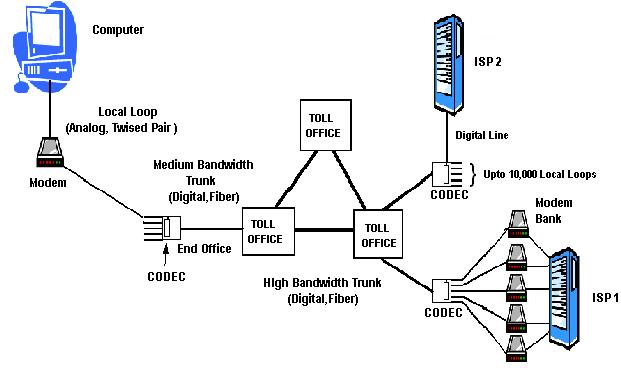Communication Networks/Local Loop
The Local Loop
[edit | edit source]In telephony, a local loop is the wired connection from a telephone company's end office to customer’s houses or small businesses. It is also referred as “last mile” although it can be up to several miles. The connection is usually of twisted pair copper wire. The system was originally designed for voice transmission only using analog transmission technology on a single voice channel. A computer can also send the digital data over this analog connection. For this the data is needed to be changed from digital to analog form so that it can be transmitted over the same local loop.Modem and codec is used to do this conversion of data. During the transmission of the data transmission lines mainly suffer three kinds of losses:
(i) Attenuation:-The Loss occurred due the loss of energy.
(ii) Distortion:- Due to the propagation speed v/s frequency.
(iii) Noise:-it is unwanted energy from source other than the transmitter.
MODEM
[edit | edit source]A modem (from modulate and demodulate) is a device that modulates an analogue carrier signal to encode digital information, and also demodulates such a carrier signal to decode the transmitted information. The goal is to produce a signal that can be transmitted easily and decoded to reproduce the original digital data. A MODEM accepts a serial stream of bits as a input and produce a carrier modulated by one or more by different modulation techniques.
Modulation Techniques
[edit | edit source]The AC signal is used in the telephone Lines Because DC Signaling is not Suitable due to the square waves have a wide frequency spectrum and this is why they are more prone to strong attenuation and delay Distortion.
Amplitude Modulation:- In Amplitude Modulation two different amplitudes are used to represent 0 and 1.
Frequency Modulation/Frequency Shift Keying:- In FM two different tones are used. Tones are also called as keys.
Phase Modulation In the PM the carrier wave is systematically shifted 0 or 180 degrees at uniform spaced intervals.
All advance modem use a combination of modulation techniques to transmit multiple bits per baud. Most of the times multiple amplitude and phase shift are combined to transmit several bits/symbol.
Sampling
[edit | edit source]To get the higher speed we just cannot increase the sampling rate. The most modem samples at 2400 times/sec or 2400 baud. A Baud is the number of samples per second. If n is the number of bits that are sent in a baud then the rate of the modem = n*2400 bps. The rate of the modem can be increased by increasing the number of bits that are to be sent in baud.
There are various ways to pack more bits in a baud, so that our objective can be achieved. If a symbol consists of 0 volts for logical 0 and 1 volt for logical 1, then the bit rate is 2400 bps.
QPSK (Quadrature Phase Shift Keying) In QPSK each symbol consist of 2 bits. Its bit transfer rate is twice of the baud rate. So it transfers a 4800bps over a 2400 baud line.
QAM-16 (Quadrature Amplitude Modulation) In QAM-16 each symbol is consist of 4 bits, its bit transfer rate is Four times of the baud rate. So it transfers 9400bps over a 2400 baud line. In this four amplitude and four phase are used, for a total of different 16 combinations. This modulation technique can transmit 4 bits per symbol.
QAM-64 A method of modulating digital signals uses both amplitude and phase coding. It can be used for downstream and used for upstream.In QAM-64 each symbol is consist of 6 bits, its bit transfer rate is Four times of the baud rate. So it transfers 9400bps over a 2400 baud line.
TCM(Trellis Coded Modulation) Even a small amount of noise in the detected phase and amplitude can result in the big error and many bad bits. To reduce the chance of error high standard modems does error correction by adding extra bit to each sample.
V.32 modem standard uses 32 constellation points to transmit 4 data bits and 1 parity bit per symbol at 2400baud to achieve 9400bps with error correction.
V.32 bis modem standard uses 128 constellation points to transmit 6 data bits and 1parity bits per symbol at 2400 baud to achieve 14000 bps with error correction.
V.34 runs at the speed of 28,800 bps at 2400 baud with 12 data bits per symbol.
V.34 the final modem in this series achieved the speed of 33600 which uses the 14 bits/symbol at 2400 baud
'V.90 provides 33.6K upstream (from user to ISP) and 56K downstream channel (from ISP to user).
V.92 can provide 48 kbps on upstream channel if the line can handle it. The downstream rate is 56Kbps.



